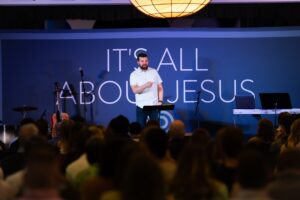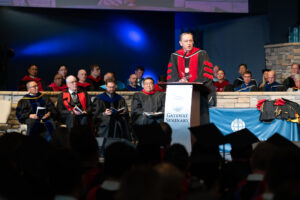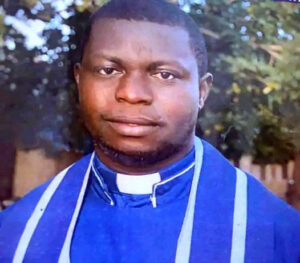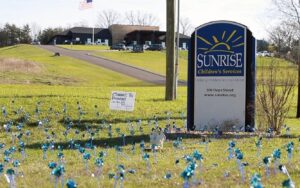
NASHVILLE (BP) — Southern Baptists are putting their CP treasure where their missional heart is, according to the most recent Cooperative Program survey conducted by LifeWay Research. (See today’s [INSERT URL] Baptist Press story on the survey’s findings.)
The Southern Baptist Convention was created to elicit, combine and direct the energies of Baptists “for the propagation of the Gospel,” as noted in the SBC’s 1845 charter. The convention’s formal purpose, meanwhile, is the “promotion of Christian missions at home and abroad,” according to its constitution.
And the convention has embraced a missional vision to “present the Gospel of Jesus Christ to every person in the world and to make disciples of all the nations,” stemming from messengers’ approval of the final report Great Commission Task Force of the Southern Baptist Convention in 2010.
To help accomplish these goals, the convention adopted a program of cooperative giving we today call the Cooperative Program.
A comprehensive vision
The Cooperative Program is the means by which Southern Baptists work together to provide financial support for the missions and ministries in their respective states, across the nation and around the world.
For 87 years, the Cooperative Program has provided Southern Baptists a cooperative means to fulfill a missional vision of building what Frank Page, president of the SBC Executive Committee, calls “A Strong Home Base with an Aggressive Global Vision!”
In cooperation with CP-funded state convention ministries and the SBC ministries of the North American Mission Board, the Ethics & Religious Liberty Commission and the six SBC seminaries, local churches seek to establish a strong home base.
In partnership with the CP-funded SBC International Mission Board and state convention overseas partnerships, local churches champion an aggressive global vision.
A look to the past
State conventions, many of which existed prior to the founding of the SBC, already were engaged in vibrant ministries such as colleges, hospitals, orphanages and a host of missions societies.
Formation of the SBC provided new opportunities to engage in an aggressive vision of missions and evangelism. It also created new challenges. These new SBC ministries drew their support from the same churches that provided funds for state ministries. Soon, representatives from all of these ministries flooded the churches with financial appeals.
The outcome of this “direct-appeal” approach was less than ideal. More visible ministries received larger offerings while other important ministries suffered in want. Support for all ministries was unpredictable from one year to the next. As the number of ministries increased, available resources to support them was diluted. In some instances, the cost of raising funds reached as high as 50 percent of the amount raised.
Church and ministry leaders were frustrated with the time, effort and money it took to generate a never-sufficient financial base. The convention needed to “elicit, combine, and direct” its financial resources fairly and dependably.
A biblical model
Facing desperate circumstances, the SBC acted to address its continuing financial challenges. In 1923, the convention commissioned the “Committee on Future Program” to come up with a solution.
The committee wanted a plan that was biblical — one that would incorporate both storehouse tithing and special offerings; rational — one that would address all essentials of ministry in proper proportion; and dependable — one that would provide consistent, equitable support for the ministries Baptists deemed essential in their respective states and in the Southern Baptist Convention.
The committee sought to develop an overarching strategy that would produce consistent, long-lasting results. It wanted a program of giving that encouraged regular contributions by churches. It aimed for convention-wide coordination and proportionate distribution.
Two years later, when Southern Baptists gathered in Memphis, Tenn., for their annual meeting, the committee introduced a plan they believed would be coordinated and fruitful. Their proposal utilized the biblical ideals of obedient giving, on a regular basis, in proportion to one’s blessing from God (1 Corinthians 16:2). They called it the “Co-Operative Program of Southern Baptists.”
A simple plan
The design of the Cooperative Program is remarkably simple:
— Churches pray over and approve their annual budgets based on anticipated tithes and offerings from their members.
— Cooperating churches prayerfully commit to give a percentage of their undesignated receipts through the CP.
— That percentage is sent to the state convention on a monthly basis and becomes the basis of the state convention’s ministry budget.
— Each cooperating state convention prayerfully commits to send a portion of its CP contributions to the SBC for distribution to the convention’s missions and ministries.
— The SBC determines an appropriate allocation for each of its approved ministries, following a model of prayerful reflection and messenger approval.
The original plan called for states to deduct the costs of promoting the CP, with a goal of forwarding 50 percent of the remainder to the SBC for its missions and ministries. As the 2010 Great Commission Task Force report showed, this goal continues to resonate with Southern Baptists.
A generation of success
During that first year, cooperating churches contributed an average of nearly 11 percent of their undesignated contributions to this new, integrated plan for supporting convention missions and ministries. This level of response continued for more than 60 years: From 1925 through 1989, cooperating churches continued to forward an average of 10 percent of their undesignated gifts through the Cooperative Program.
During this same 60-year period, the SBC portion of the CP forwarded from the states fluctuated between a low of 26 percent during the Great Depression to a high of 39 percent in 1989. Following a slow decline through the 1990s, the percentage forwarded by the states began rising steadily in 2002 and now stands again at nearly 39 percent.
At this level of support from the churches through their respective state conventions, the SBC was able to enlist, empower and equip the largest evangelical missions force in the world — full-time field personnel fulfilling their ministry goals without the distraction of needing to raise their own support. The convention also built a consortium of low-cost theological education unrivaled in Christian history.
Changing times
The SBC was not immune from the societal and demographic changes traced by Princeton sociologist Robert Wuthnow in his twin books, “The Restructuring of American Religion” (1988) and “The Struggle for America’s Soul” (1989). In the almost 25 years since his groundbreaking works, commitment to denominational structures has only gotten weaker.
As the new LifeWay Research survey shows, Southern Baptists pastors who are 55 and older are more likely to support the Cooperative Program, believing the CP supports missions and ministries their churches value. They also are more likely to think convention entities use their CP contributions effectively and to place a higher value on the ministries the CP supports.
Younger pastors (ages 18–44) are less likely to believe the convention’s entities use their CP contributions effectively and are less willing to agree that the CP supports SBC ministries and missions their churches value. It is also interesting that, according to the survey, younger pastors are less likely to say improving the vitality and health of existing churches and developing an evangelism strategy for North America are essential.
Few of today’s Southern Baptists were alive when the failed system called “societal giving” held sway. Most are unaware of the devastating failure of the Seventy-Five Million Campaign during the opening decades of the 20th century. Promising great success with more than $92 million pledged, the capital fund program only generated $58 million, plunging the convention’s entities into massive debt and threatening their very existence.
Changing demographics
Over the past two decades, Southern Baptists’ greatest growth has been among ethnic congregations. Many of these newer churches are unacquainted with the history, value and successes of the Cooperative Program. As they become more fully informed about the missional impetus behind the CP, their support for the CP is increasing. Some ethnic churches, having been planted or assisted through Cooperative Program investment, already share a missional commitment to the CP. They believe in the principles of cooperative giving and support the CP as a key component of their missions giving strategy.
A tipping point
While the dollar amounts contributed through the Cooperative Program continued to increase through 2008, the average percentage forwarded by the churches to their respective state conventions began a downward slide in the late 1980s. Over the past two and a half decades, the average percentage forwarded from the churches through the CP has declined by almost one half — from 10.52 percent in 1987 to 5.41 percent in 2011.
Messengers from cooperating churches must join SBC entity leaders by thinking about the question, “Does there come a point at which we can no longer count on the CP as a dependable source of funding for our collective Kingdom ministries?” And, relatedly, “What other options do we have?”
Convention leadership at every level must continually take strides to build the trust that is the glue that holds the convention’s missions and ministry enterprises together. The LifeWay Research survey is encouraging in that it shows the majority believe God still desires to use CP-funded missions and ministries to fulfill His Kingdom enterprises. The survey is instructive in that it reminds us that trust must be earned from one generation to the next to undergird a Strong Home Base in order to maintain an Aggressive Global Vision for presenting the Gospel of Jesus Christ to every person in the world.
–30–
Roger S. Oldham is vice president for convention communications and relations with the SBC Executive Committee and executive editor of its journal, SBC LIFE, where this article first appeared. Portions of this essay are adapted drawn from “Forged by Faith … One Sacred Effort,” the second DVD in the Forged by Faith series, based in concept on the book by Chad Owen Brand and David E. Hankins titled “One Sacred Effort: The Cooperative Program of Southern Baptists” (Nashville: Broadman and Holman, 2005). The Forged by Faith collection is available online at www.sbc.net/ForgedByFaith














